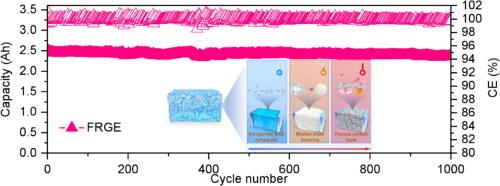A flame-retardant and weakly solvated gel electrolyte for high-performance and high-safety Ah class sodium-ion batteries
IF 13.2
1区 工程技术
Q1 ENGINEERING, CHEMICAL
引用次数: 0
Abstract
Phosphate-based electrolytes can effectively improve flame retardancy of sodium-ion batteries (SIBs), but there is a problem of incompatibility with carbon based electrodes. Here, a flame-retardant gel electrolyte (FRGE) strategy can solve the above problems simultaneously by adopting perfluorinated electrolyte and high content of phosphate ester, and cross-linked gel polymer matrix. The electrolyte solvation structure is optimized by the electrostatic adsorption action of the gel, which prompts the entry of anions into the first solvation layer, forming more ion aggregates (AGGs) and contact ion pairs (CIPs). The FRGE enhances the interaction between Na-ion and the PF6− anion, promoting the decomposition of the anion at the interface to form a stable dense fluorinated SEI film, while reducing the possibility of phosphate ester co-embedding in the carbon-based anode. Remarkably, the designed 2.4 Ah Na0.9[Cu0.22Fe0.3Mn0.48]O2/HC pouch cell incorporating FRGE demonstrates an impressive low-capacity degradation rate of 0.0035 % per cycle over 1000 cycles, attesting to a high energy density of 124.6 Wh kg−1. The composite gel electrolyte not only enhances flame retardancy but also boosts electrochemical properties, furthering the practical application of SIBs.

一种用于高性能、高安全Ah级钠离子电池的阻燃弱溶剂化凝胶电解质
磷酸盐基电解质可以有效提高钠离子电池的阻燃性,但存在与碳基电极不相容的问题。本文提出了一种阻燃凝胶电解质(FRGE)策略,通过采用全氟电解质和高含量的磷酸酯,以及交联凝胶聚合物基质,可以同时解决上述问题。凝胶的静电吸附作用优化了电解质的溶剂化结构,促使阴离子进入第一溶剂化层,形成更多的离子聚集体(AGGs)和接触离子对(cip)。FRGE增强了na -离子与PF6−阴离子之间的相互作用,促进了阴离子在界面处的分解,形成稳定致密的含氟SEI膜,同时降低了磷酸酯在碳基阳极共包埋的可能性。值得注意的是,设计的含有FRGE的2.4 Ah Na0.9[Cu0.22Fe0.3Mn0.48]O2/HC袋状电池在1000次循环中显示出令人印象深刻的每循环0.0035 %的低容量降解率,证明了124.6 Wh kg−1的高能量密度。复合凝胶电解质不仅提高了阻燃性能,而且提高了电化学性能,进一步促进了sib的实际应用。
本文章由计算机程序翻译,如有差异,请以英文原文为准。
求助全文
约1分钟内获得全文
求助全文
来源期刊

Chemical Engineering Journal
工程技术-工程:化工
CiteScore
21.70
自引率
9.30%
发文量
6781
审稿时长
2.4 months
期刊介绍:
The Chemical Engineering Journal is an international research journal that invites contributions of original and novel fundamental research. It aims to provide an international platform for presenting original fundamental research, interpretative reviews, and discussions on new developments in chemical engineering. The journal welcomes papers that describe novel theory and its practical application, as well as those that demonstrate the transfer of techniques from other disciplines. It also welcomes reports on carefully conducted experimental work that is soundly interpreted. The main focus of the journal is on original and rigorous research results that have broad significance. The Catalysis section within the Chemical Engineering Journal focuses specifically on Experimental and Theoretical studies in the fields of heterogeneous catalysis, molecular catalysis, and biocatalysis. These studies have industrial impact on various sectors such as chemicals, energy, materials, foods, healthcare, and environmental protection.
 求助内容:
求助内容: 应助结果提醒方式:
应助结果提醒方式:


